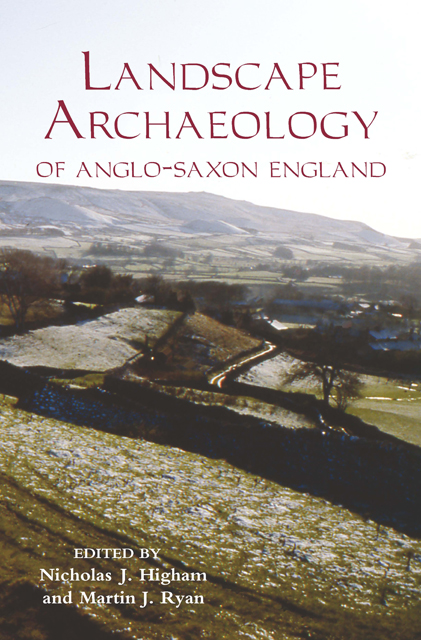Book contents
- Frontmatter
- Contents
- List of Illustrations
- Contributors
- Acknowledgements
- Abbreviations
- 1 The Landscape Archaeology of Anglo-Saxon England: An Introduction
- 2 Barriers to Knowledge: Coppicing and Landscape Usage in the Anglo-Saxon Economy
- 3 Landscape Change during the ‘Long Eighth Century’ in Southern England
- 4 Population Ecology and Multiple Estate Formation: The Evidence from Eastern Kent
- 5 Exploring Black Holes: Recent Investigations in Currently Occupied Rural Settlements in Eastern England
- 6 Medieval Field Systems and Settlement Nucleation: Common or Separate Origins?
- 7 The Environmental Contexts of Anglo-Saxon Settlement
- 8 Calendar Illustration in Anglo-Saxon England: Realities and Fictions of the Anglo-Saxon Landscape
- 9 The Anglo-Saxon Plough: A Detail of the Wheels
- 10 ‘In the Sweat of thy Brow Shalt thou eat Bread’: Cereals and Cereal Production in the Anglo-Saxon Landscape
- 11 The Early Christian Landscape of East Anglia
- 12 The Landscape and Economy of the Anglo-Saxon Coast: New Archaeological Evidence
- Index
11 - The Early Christian Landscape of East Anglia
Published online by Cambridge University Press: 16 February 2023
- Frontmatter
- Contents
- List of Illustrations
- Contributors
- Acknowledgements
- Abbreviations
- 1 The Landscape Archaeology of Anglo-Saxon England: An Introduction
- 2 Barriers to Knowledge: Coppicing and Landscape Usage in the Anglo-Saxon Economy
- 3 Landscape Change during the ‘Long Eighth Century’ in Southern England
- 4 Population Ecology and Multiple Estate Formation: The Evidence from Eastern Kent
- 5 Exploring Black Holes: Recent Investigations in Currently Occupied Rural Settlements in Eastern England
- 6 Medieval Field Systems and Settlement Nucleation: Common or Separate Origins?
- 7 The Environmental Contexts of Anglo-Saxon Settlement
- 8 Calendar Illustration in Anglo-Saxon England: Realities and Fictions of the Anglo-Saxon Landscape
- 9 The Anglo-Saxon Plough: A Detail of the Wheels
- 10 ‘In the Sweat of thy Brow Shalt thou eat Bread’: Cereals and Cereal Production in the Anglo-Saxon Landscape
- 11 The Early Christian Landscape of East Anglia
- 12 The Landscape and Economy of the Anglo-Saxon Coast: New Archaeological Evidence
- Index
Summary
This paper explores aspects of the historical and archaeological evidence for the coming of Christianity to Anglo-Saxon East Anglia with a particular focus on the wide-scale restructuring of the landscape that the conversion precipitated (Fig. 11.1). In order to establish the historical framework within which these events sit, it begins with an examination of the evidence presented by Bede in the Historia Ecclesiastica. Bede draws our attention to some of the ecclesiastical sites established by the early churchmen; a broader consideration of the conversion-period landscape reveals many important sites that are not mentioned in the surviving historical sources. In particular, disused Roman enclosures and topographically distinct locations can be demonstrated to have been of particular significance to the conversion process. The coming of Christianity also caused a great upheaval in the sites chosen for cemeteries, argued to be a direct result of a changing attitude towards the dead, which resulted in the integration of cemeteries and settlements during the Middle Saxon period. Finally, this paper offers some suggestions about how we might take the study of the conversion-period landscape further.
The Historical Framework
One of the main themes of Bede's Historia Ecclesiastica is the gradual conversion of the Anglo-Saxon kingdoms – a feat most often achieved via royal patronage, the establishment of the episcopal sees and the encouragement of missionary activity. East Anglia was no exception and Bede emphasises the role that the East Anglian kings played in the Christianisation of the region, the most important developments in his eyes being the establishment of the bishopric at Dommoc and the encouragement of the missionary Fursa. Yet we must proceed with caution, for Bede was primarily a theologian and his motives for writing the HE were more than simply to provide an historical account, as we would understand it, of the English Church. Consequently, we must be wary of taking the historical framework Bede presented at face value, but at the same time we must make the most of what information we do have.
It is clear from the text of the HE that very little of Bede's East Anglian material was derived from East Anglian sources, instead being drawn from Northumbrian sources as well as those of Wessex, Essex and Kent.
- Type
- Chapter
- Information
- The Landscape Archaeology of Anglo-Saxon England , pp. 193 - 210Publisher: Boydell & BrewerPrint publication year: 2010



